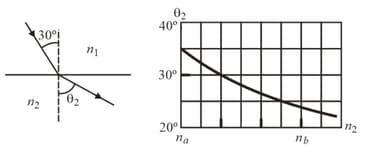In the figure, a broad beam of monochromatic light is directed perpendicularly through two glass plates that are held together at one end to create a wedge of air between them. An observer intercepting the light reflected from the wedge of air, which acts as a thin film, sees dark fringes along the length of the wedge. When the air between the plates is evacuated, only dark fringes are seen. Calculate to six significant figures the index of refraction of air from these data.
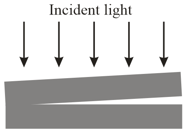

Important Questions on Interference
In the figure below, a broad beam of light of wavelength is sent directly downward through the top plate of a pair of glass plates. The plates are long, touch at the left end, and are separated by at the right end. The air between the plates acts as a thin film. How many bright fringes will be seen by an observer looking down through the top plate?
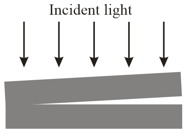
Two rectangular glass plates are in contact along one edge and are separated along the opposite edge (Figure). Light with a wavelength of is incident perpendicularly onto the top plate. The air between the plates acts as a thin film. Nine dark fringes and eight bright fringes are observed from above the top plate. If the distance between the two plates along the separated edges is increased by how many dark fringes will there then be across the top plate?
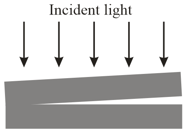
Two waves of light in air, of wavelength are initially in phase. Then they both travel through a layer of plastic as shown in the figure with and (a) What multiple of gives their phase difference after they both have emerged from the layers? (b) If the waves later arrive at some common point with the same amplitude, is their interference fully constructive, fully destructive, intermediate but closer to fully constructive, or intermediate but closer to fully destructive?
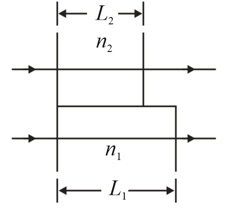
A thin film of liquid is held in a horizontal circular ring, with air on both sides of the film. A beam of light at wavelength is directed perpendicularly onto the film, and the intensity of its reflection is monitored. The figure gives intensity as a function of time , the horizontal scale is set by The intensity changes because of evaporation from the two sides of the film. Assume that the film is flat and has parallel sides, a radius of and an index of refraction of Also assume that the film's volume decreases at a constant rate. Find that rate.

In the figure (a), a beam of light in material is incident on a boundary at an angle of The extent to which the light is bent due to refraction depends, in part, on the index of refraction of material Figure (b) gives the angle of refraction versus for a range of possible values, from to What is the speed of light in material
